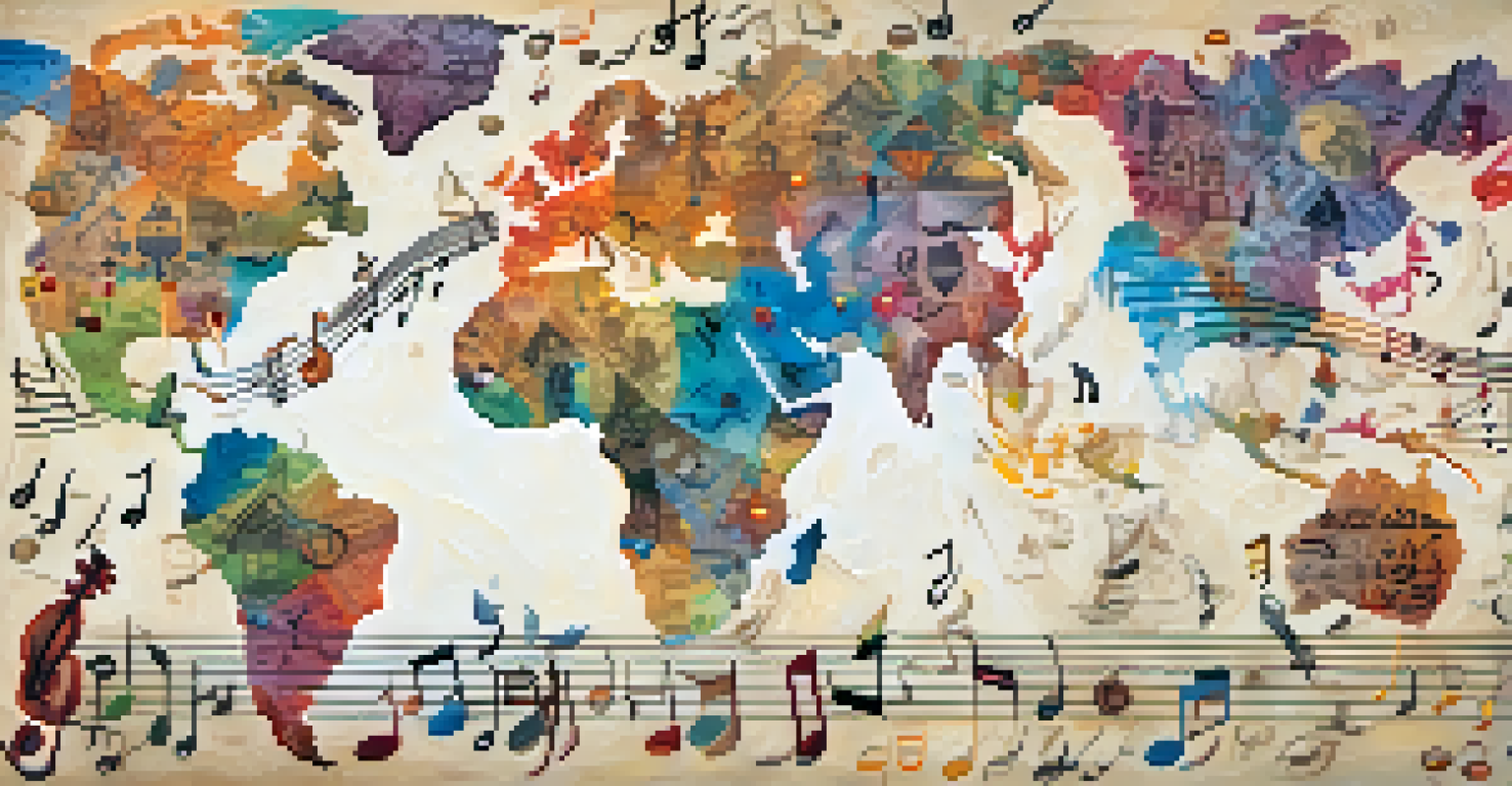Cultural Influences in Film Score Composition Techniques

Understanding Film Scores and Their Importance
Film scores serve as the emotional backbone of a movie, guiding viewers through the narrative. They enhance storytelling by creating atmospheres that resonate with the audience’s feelings. Without a well-composed score, even the most visually stunning scenes can fall flat, emphasizing the significant role music plays in film.
Music can change the world because it can change people.
Composers often draw upon cultural elements to create scores that reflect the themes and settings of the film. For instance, a score infused with traditional Asian instruments can evoke the cultural identity of a story set in Japan. This connection helps audiences immerse themselves in the film's world and understand its nuances on a deeper level.
Ultimately, film scores not only complement visuals but also serve as a storytelling device in their own right. They can evoke nostalgia, tension, or joy, depending on the narrative's requirements. By weaving cultural influences into their compositions, filmmakers can create a richer, more impactful cinematic experience.
The Role of Cultural Context in Composition
Cultural context is crucial in shaping how composers approach film scoring. It involves understanding the historical, social, and emotional landscapes of the film’s setting. For example, a composer may incorporate indigenous sounds to connect the audience to a specific cultural narrative, enhancing authenticity.

Composers often research the cultural backgrounds relevant to their films to ensure accuracy in representation. This could include studying traditional music forms, instruments, and even local folklore. By doing so, they create scores that resonate with the cultural origins depicted on screen, fostering a genuine connection.
Film Scores Enhance Emotional Impact
Film scores serve as the emotional backbone of movies, guiding viewers through the narrative and enriching the storytelling experience.
Furthermore, cultural context can also influence the emotional weight of a score. Composers who grasp the subtleties of cultural expressions can evoke more profound emotional responses from the audience, enriching their viewing experience. This highlights the importance of cultural awareness in the art of film scoring.
Incorporating Traditional Instruments in Film Scores
Many composers turn to traditional instruments to infuse their scores with a sense of place and heritage. For instance, the use of the sitar in a Bollywood film not only highlights the cultural backdrop but also adds unique tonal qualities to the music. These instruments often carry historical significance, further deepening the audience's connection to the film.
The more you know about a culture, the more you can connect with it through music.
Incorporating traditional instruments can also introduce audiences to sounds they may not be familiar with, expanding their musical palette. This blend of modern scoring techniques with ancient sounds can create a captivating contrast that enhances the film’s narrative. It’s a way to bridge the gap between the past and present, making the score feel timeless.
Moreover, traditional instruments can evoke specific emotions tied to cultural practices and rituals. For example, the haunting notes of an Irish Uilleann pipe can instantly transport viewers to the emerald landscapes of Ireland, evoking feelings of nostalgia or longing. This strategic use of instruments showcases how cultural influences can transform a film score.
Cross-Cultural Collaborations in Film Scoring
In today’s globalized world, cross-cultural collaborations have become increasingly popular in film scoring. Composers from diverse backgrounds often come together to create scores that celebrate multiculturalism. This blend of styles not only enriches the music but also reflects the interconnectedness of global stories.
For example, a film set in multiple countries might feature a score that combines elements from various cultural traditions. This can create a unique soundscape that mirrors the film's narrative arc and its diverse characters. Collaborations often lead to innovative compositions that challenge traditional boundaries and inspire new musical directions.
Cultural Context Shapes Composition
Understanding cultural context enables composers to create authentic scores that resonate with the film's themes and enhance audience connection.
These partnerships also promote cultural exchange, allowing composers to learn from each other's techniques and traditions. By sharing knowledge and experiences, they can create scores that resonate with a wider audience. This collaborative spirit embodies the essence of storytelling, showcasing how music can unite diverse cultures.
Using Melodic Themes to Represent Cultures
Melodic themes can serve as powerful symbols of cultural identity within film scores. Composers often create motifs that represent specific characters, places, or ideas, weaving them throughout the score. For instance, a recurring melody associated with a hero can evoke feelings of strength and resilience, while a softer theme may represent vulnerability.
These motifs can also draw from cultural musical traditions, giving them a distinctive flavor that enhances their significance. By using scales, rhythms, or harmonic patterns unique to a culture, composers can create melodies that not only tell a story but also celebrate its roots. This adds layers of meaning that can resonate deeply with audiences familiar with those traditions.
Additionally, the repetition of these themes throughout the film can evoke emotional responses and create a sense of familiarity. As viewers hear the motifs, they associate them with particular moments or emotions, making the overall experience more impactful. This technique illustrates how cultural influences can shape the listener's perception through memorable musical storytelling.
The Impact of Cultural Identity on Composers
A composer’s cultural identity often shapes their artistic voice, influencing the way they approach film scoring. Composers from different backgrounds bring unique perspectives and experiences to their work, which can lead to innovative and authentic scores. Their cultural heritage can inform their choices in instrumentation, melody, and even the emotional tone of the music.
For example, a composer with roots in African music traditions may incorporate polyrhythms and call-and-response patterns into their scores, creating a lively and dynamic sound. These elements not only reflect their background but also contribute to the film's cultural authenticity. The composer’s personal connection to their heritage enriches the music, making it more resonant.
Challenges of Cultural Representation
Composers face the challenge of accurately representing cultural elements in their scores, necessitating sensitivity and collaboration to avoid misrepresentation.
Furthermore, cultural identity can also foster a sense of pride and purpose in a composer’s work. When they score a film that reflects their culture, it becomes an opportunity to share their heritage with a broader audience. This can lead to greater representation in the film industry, showcasing the importance of diverse voices in storytelling.
Challenges of Cultural Representation in Film Music
While incorporating cultural influences into film scores can be powerful, it also presents challenges. Misrepresentation or appropriation of cultural elements can lead to backlash from communities whose traditions are being depicted. Composers must navigate these complexities with sensitivity and awareness to avoid perpetuating stereotypes.
Research and collaboration with cultural experts can help composers create more authentic representations in their music. By engaging with the communities they are drawing from, composers can gain insights that enhance their understanding and ensure respectful representation. This collaboration is crucial for fostering authenticity in film scores.

Additionally, composers may face the challenge of balancing artistic expression with cultural fidelity. They want to create music that resonates with a global audience while remaining true to the cultural roots they draw from. Finding this balance requires a thoughtful approach and an openness to feedback, ultimately leading to more meaningful and respectful film scores.